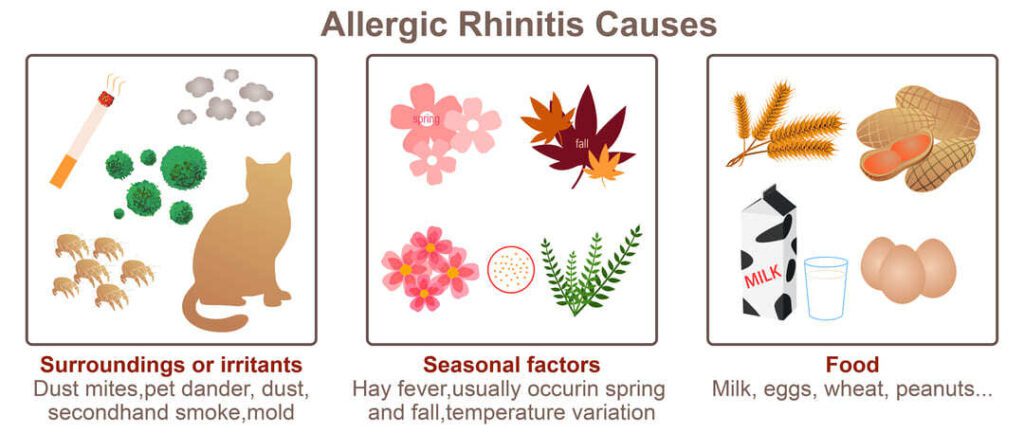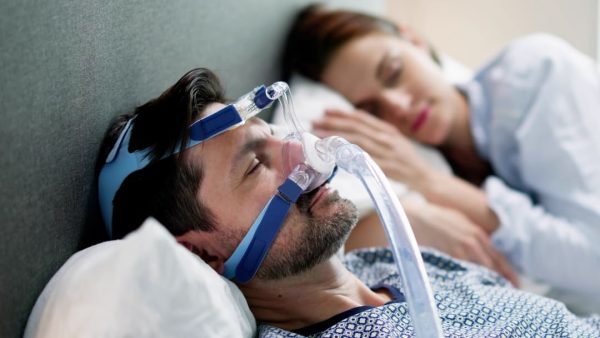Looking for Expert-Level VA Claim Answers?📱Call Us Now! 737-295-2226
This guide will help you understand possible VA secondary conditions to allergic rhinitis.
Veterans often suffer from a range of secondary conditions that are related to their allergic rhinitis.
These are known as secondary conditions and can vary depending on the person.
Whether you’re just starting to explore your options or are looking for more information on specific secondary conditions, our guide comprehensively looks at veterans’ most common secondary conditions associated with allergic rhinitis.
Table of Contents

Deserve a HIGHER VA Rating?
Learn more about how VA Claims Insider can help you get the rating you DESERVE!
Book a no-obligation Discovery Call today!
VA Secondary Conditions to Allergic Rhinitis
Unfortunately, allergic rhinitis can also lead to other conditions known as secondary conditions. In some cases, these secondary conditions can be more serious than the allergic rhinitis itself.
For example, people with allergic rhinitis are also more likely to develop other respiratory conditions, such as asthma.
As a result, it’s important to be aware of allergic rhinitis’s potential complications and seek treatment if symptoms of other conditions develop.
Sleep Apnea Secondary to Allergic Rhinitis VA Disability
Allergic rhinitis can be a nuisance, but for some people, it can also lead to serious health problems, such as developing obstructive sleep apnea. Obstructive sleep apnea is a sleep disorder that causes interrupted breathing during sleep. It can lead to daytime fatigue, moodiness, and difficulty concentrating.
Secondary service connection sleep apnea to allergic rhinitis is a recognized condition by the VA. Veterans who suffer from sleep apnea secondary to allergic rhinitis may be eligible for VA disability benefits.
If you’re a veteran with sleep apnea secondary to allergic rhinitis and believe you are entitled to VA disability benefits, it’s important to seek guidance.
VA Rating for Sleep Apnea Secondary to Allergic Rhinitis
The VA rates service-connected sleep apnea secondary to allergic rhinitis at either 0%, 30%, 50%, or 100% disabling, depending on the severity of your symptoms. People with both conditions are eligible for benefits, including monthly disability payments and free health care from the VA.
In addition, people with sleep apnea secondary to allergic rhinitis may be eligible for Social Security Disability Insurance (SSDI). To receive benefits, applicants must prove that their conditions prevent them from working.

Sinusitis Secondary to Allergic Rhinitis VA Disability
Allergic rhinitis is a condition that can cause chronic sinusitis, which is an inflammation of the sinuses. Allergic rhinitis is caused by an allergy to something in the environment. When someone with allergic rhinitis breathes in substances such as pollen, dust, or pet dander, they can cause the inside of the nose to become inflamed and swollen. It can lead to a blockage of the sinuses, which can become infected.
Sinusitis secondary to allergic rhinitis is a condition that can be disabling. It can cause severe headaches, facial pain, and difficulty breathing. Sinusitis and rhinitis can also sometimes aggravate sleep apnea. If this condition impacts your ability to work, you may be eligible for VA disability benefits.
VA Rating for Sinusitis Secondary to Allergic Rhinitis
Veterans who suffer from sinusitis secondary to allergic rhinitis may be eligible for a disability rating from the VA. The VA rates sinusitis at either 0%, 10%, 30% or 50%, depending on the frequency and severity of the symptoms.
If your sinusitis is secondary to your allergic rhinitis, it means that your sinusitis is caused or aggravated by your service-connected rhinitis. To receive a VA rating for your condition, you must provide medical evidence showing that your sinusitis is directly related to your allergies. This evidence can come from doctor notes, laboratory test results, other medical records, and, most importantly, a medical nexus letter linking the two conditions.
Once you have provided this evidence, the VA will review your case and determine whether you are eligible for benefits.
Asthma Secondary to Allergic Rhinitis VA Disability
For some people, asthma is triggered by allergies.
Asthma secondary to allergic rhinitis can be difficult to control and significantly impact a person’s quality of life. Asthma secondary to allergic rhinitis is a recognized condition for VA disability benefits (and tax-free compensation).
VA Rating for Asthma Secondary to Allergic Rhinitis
The VA has established a rating schedule for asthma that considers the presence of allergic rhinitis.
The VA rates asthma according to the frequency and severity of asthmatic attacks and the effect of the condition on daily activities. The VA rates asthma at either 10%, 30%, 60%, or 100%, depending on the frequency and severity of the symptoms.

Migraines Secondary to Allergic Rhinitis VA Disability
Migraines can be caused by several factors, including stress, bright lights, and certain foods. However, for some people, migraines are triggered by allergic reactions, and for some with allergic rhinitis, these symptoms can trigger a migraine.
If you suffer from migraines secondary to allergic rhinitis, you may be eligible for VA disability benefits. You will need to provide medical evidence of your condition to receive benefits. It should include a diagnosis and a medical nexus letter linking the two conditions. If you provide this evidence, the VA will consider your claim and determine whether you are eligible for benefits.
VA rating for Migraines Secondary to Allergic Rhinitis
Veterans suffering from migraines may be eligible for disability benefits if their condition is service-connected. Various factors can cause migraines, but to receive a VA rating for migraines secondary to rhinitis, veterans must provide evidence that their migraines are caused or aggravated by their service-connected allergic rhinitis.
Veterans with migraines determined to be secondary to another service-connected condition may be eligible for a disability rating of 0%, 10%, 30%, or 50%, depending on the frequency and severity of the symptoms.
We hope this guide has been helpful. We’re VA insiders here to walk you through everything you need to know. Remember, if you have any questions, we encourage you to contact us for support.

Frequently Asked Questions
What Is the Difference Between Allergic Rhinitis and Sleep Apnea VA Disability?
Sleep apnea is when a person’s breathing is interrupted during sleep. It can happen multiple times throughout the night and lead to daytime fatigue, difficulty concentrating, and other health problems.
Allergic rhinitis is a condition that causes sneezing, congestion, and other symptoms due to an allergic reaction. Both conditions can make it difficult to get a good night’s sleep.
Fortunately, the VA provides disability benefits for veterans with sleep apnea or allergic rhinitis. These benefits can help veterans get the treatment they need to improve their quality of life.
What Conditions Are Secondary to Allergic Rhinitis?
Conditions secondary to allergic rhinitis include conditions such as sleep apnea, sinusitis, migraines, and asthma.
Can Allergies Trigger Sleep Apnea?
Yes, allergies can trigger sleep apnea.
Allergies can trigger sleep apnea by causing nasal congestion that obstructs the airway. Allergies can also cause inflammation of the airway, which can make it more difficult to breathe.
In addition, some people with allergies are also sensitive to environmental triggers such as dust mites or pet dander. These triggers can cause an inflammatory response that leads to airway obstruction and sleep apnea.
How Does the VA Prove Sinusitis?
Veterans who experience symptoms of sinusitis may be able to receive disability benefits from the VA.
To qualify for disability benefits, veterans must undergo a thorough medical examination. When a veteran submits a claim for sinusitis, the VA will consider all of the veteran’s symptoms and medical history, including other evidence that the veteran submitted. The VA could also request a Compensation and Pension (C&P) exam to further evaluate the condition.
By working with a qualified medical professional, veterans can ensure that they are getting the care and benefits they need.
What Is the VA Disability Rating for Allergic Rhinitis?
You can obtain the necessary benefits to improve your quality of life with the right documentation. The highest rating for allergic rhinitis is 30%, corresponding to severe symptoms that make it difficult to work or perform other daily activities. If you got a lower rating and you think your symptoms merit a higher rating, you can appeal the decision by submitting additional evidence or requesting a reexamination.
What Is the Average VA Disability Rating for Sinusitis?
The VA typically rates 0%, 10%, 30%, and 50% for sinusitis. The severity of symptoms determines the disability rating given by the VA.
If there are 1 or 2 incapacitating episodes each year that require 4 to 6 weeks of antibiotic treatment, or if there are 3 to 6 episodes each year of headaches, tenderness, and the discharge of puss or crusting, it is rated 10%.
If the sinusitis is constant or near-constant with headaches, tenderness to the touch, and the discharge of puss or crusting after repeated surgeries, or if a Radical Surgery was performed and there is an ongoing infection in the facial bones (osteomyelitis), it is rated 50%.
Can You Get Disability Compensation for Allergic Rhinitis?
If you suffer from allergic rhinitis, you may be eligible for disability compensation. To qualify for benefits, you must be able to show that you have a medical diagnosis and a medical nexus letter linking your condition to your service or service-connected condition. You may also provide documentation of your symptoms and how they affect your ability to function.
Is Rhinitis a Presumptive Disability?
Yes. In August 2021, the VA added three conditions, including rhinitis, as a disability claim on a presumptive basis based on presumed particulate matter exposures during military service in Southwest Asia and certain other areas — if these conditions manifested within 10 years of a qualifying period of military service.
The Southwest Asia theater of operations refers to Iraq, Kuwait, Saudi Arabia, the neutral zone between Iraq and Saudi Arabia, Bahrain, Qatar, the United Arab Emirates, Oman, the Gulf of Aden, the Gulf of Oman, the Persian Gulf, the Arabian Sea, the Red Sea and the airspace above these locations.
What Is the VA Disability Rating for Asthma?
There is no set VA disability rating for asthma, as the severity of the condition can vary greatly from one individual to the next. However, the VA does offer a general disability rating for respiratory conditions, which ranges from 10% to 100%.
Asthma may fall under this category, depending on the extent of the condition. To receive benefits, individuals must first submit a claim to the VA, which will then be reviewed by a Veteran Service Representative (VSR). If it is determined that the individual’s asthma is a service-connected condition, they will be assigned a disability rating based on the severity of their symptoms.
Asthma can be difficult to manage, but with proper treatment and care, many people can live relatively normal lives. The VA’s disability benefits can help to offset some of the costs associated with managing the condition.
Is Bronchial Asthma and Allergic Rhinitis the Same?
No, bronchial asthma and allergic rhinitis are not the same. While they both involve chronic inflammation of the respiratory system, the causes and symptoms of each condition are different.
An allergy triggers allergic rhinitis to a particular substance, such as pollen or dust. Symptoms include itchiness, sneezing, and a runny nose.
The main symptom of asthma is difficulty breathing. In some cases, asthma can also cause wheezing or coughing. Bronchial asthma, on the other hand, is usually caused by an infection or exposure to irritants, such as smoke or chemical fumes.
While both conditions can be chronic and debilitating, they are not the same.
Can Allergic Rhinitis Trigger Migraines?
Allergic rhinitis may be a trigger for migraines. Migraines are a type of headache that can cause intense pain, nausea, and sensitivity to light and sound. Some people with allergic rhinitis can be more likely to experience migraines, especially during allergy season. While more research is needed to confirm this link, it is possible that treating seasonal allergies could help to prevent migraines.
Are Migraines a Side Effect of Allergies?
While the exact correlation is unclear, there are a few theories as to why the two conditions might be linked. One possibility is that histamine, a substance released during an allergic reaction, can also trigger migraines. Another theory is that allergies and migraines share a common underlying cause, such as inflammation or changes in the nervous system. Whatever the connection, it is important to seek treatment for both conditions to find relief. Talk to your doctor about possible treatments if you suffer from migraines and suspect that allergies might be to blame.
Can Non-Allergic Rhinitis Cause Migraines?
The exact cause of non-allergic rhinitis is unknown; it is thought to be triggered by changes in temperature, humidity, and air pollution levels. Although non-allergic rhinitis is not life-threatening, it can be extremely irritating and lead to several other symptoms, including headaches. Non-allergic rhinitis is a common trigger for migraines.
If you suffer from migraines, you must be aware of the potential triggers and take steps to avoid them. If you think that non-allergic rhinitis may be triggering your migraines, talk to your doctor about treatment options.
NEED MORE ASSISTANCE?
Most veterans are underrated for their disabilities and therefore not getting the compensation they’re due. At VA Claims Insider, we help you understand and take control of the claims process, so you can get the rating and compensation you’re owed by law.
Our process takes the guesswork out of filing a VA disability claim and supports you every step of the way in building a fully developed claim (FDC).
If you’ve filed your VA disability claim and have been denied or have received a low rating—or you’re unsure how to get started—reach out to us! Take advantage of a VA Claim Discovery Call. Learn what you’ve been missing—so you can FINALLY get the disability rating and compensation you deserve!
We’ve supported more than 25,000 veterans to win their claims and increase their ratings. NOW IT’S YOUR TURN.
About the Author

Brian Reese
Brian Reese is a world-renowned VA disability benefits expert and the #1 bestselling author of VA Claim Secrets and You Deserve It. Motivated by his own frustration with the VA claim process, Brian founded VA Claims Insider to help disabled veterans secure their VA disability compensation faster, regardless of their past struggles with the VA. Since 2013, he has positively impacted the lives of over 10 million military, veterans, and their families.
A former active-duty Air Force officer, Brian has extensive experience leading diverse teams in challenging international environments, including a combat tour in Afghanistan in 2011 supporting Operation ENDURING FREEDOM.
Brian is a Distinguished Graduate of Management from the United States Air Force Academy and earned his MBA from Oklahoma State University’s Spears School of Business, where he was a National Honor Scholar, ranking in the top 1% of his class.


